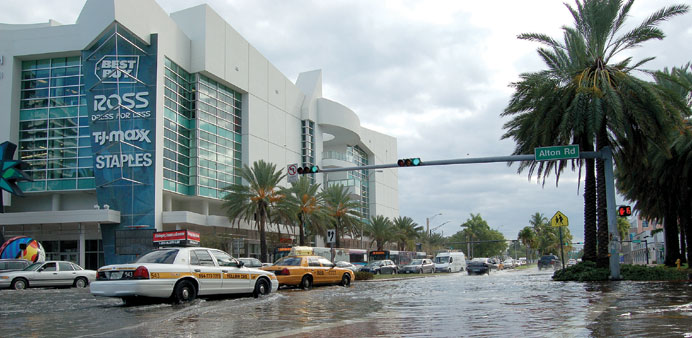GLOBAL WARMING: Cars seen driving along Alton Road, in Miami Beach. Alton Road is barely 85 centimetres above sea level and is constantly flooding.
By Daniel Garcia Marco
There have been no rainstorms and no burst water pipes, but Alton Road, one of the main avenues on touristy Miami Beach, is flooded again. Shop owners use sandbags and barriers to keep the water surging from the sewers from entering their venues.
Passersby take their shoes off to wade through puddles. The street, just a few blocks from the Atlantic Ocean, is “Ground Zero” when it comes to the disturbing rising sea levels in Miami and much of southern Florida.
Alton Road is barely 85 centimetres above sea level. Work to install water pumping stations at a cost of 32 million dollars is expected to be complete by year’s end. The intention is to cope with the problem that is also affecting millions of inhabitants and properties in the low, marshy lands in southern Florida, a tourist paradise threatened by climate change.
A federal assessment in May identified Miami as one of the cities most vulnerable to climate change.
“The US Army Corps of Engineers has projected that the water around Miami could rise up to 24 inches (60 centimetres) by 2060. The projections are alarming, particularly for a city like Miami Beach that has an average elevation of 4.4 feet (1.3 metres),” said the Mayor of Miami Beach, Philip Levine, before the US Senate Committee on Commerce, Science and Transportation in a special session held in Miami in April.
Levine and many Florida politicians are more convinced than other political leaders in the United States about the reality of climate change. There is no time to be sceptical. They are floundering in water and survival is at stake.
Miami Beach, a Mecca for sun and beach lovers, is very much aware that a problem exists because of the floods, high tides and rising subterranean water levels. Scientists warn that extreme weather events like storms, hurricanes and floods will increase in frequency and strength.
The work being conducted along Alton Road is only one of many steps being planned to fight the rising sea. This project and other draining systems will demand an investment in the order of 300 million dollars in the next five years.
With the help of The Netherlands, an expert in containing water, Miami Beach is also updating its network of levees.
And it is not just a matter of floods. The over 40 kilometres of beaches surrounding Greater Miami are also being threatened, eroded bit by bit, at risk because they are on a hurricane path and sand banks used to replenish beaches are being depleted.
“Your pledge to preserve this critical asset is imperative to protect the future of our economy, our infrastructure and our residents,” Levine told the senators.
Miami authorities fear that tourism, the region’s economic motor, could be at risk. In 2013, Miami Beach welcomed 14.2 million visitors who spent at least one night there and disbursed 22.8 billion dollars, according to city data.
“Due to climate change, the future of Miami Beach and other coastal communities has become more uncertain,” Levine added.
About 45 per cent of tourists who arrived in the Greater Miami area in 2013 chose the beaches, restaurants and nightlife of Miami Beach for entertainment and dining.
Fred Bloetscher — an Associate Professor with the Department of Civil, Environmental and Geomatics Engineering at Florida Atlantic University — also sounded the alarm bell before the committee.
“It is clear that the percentage of land that will be impacted on a daily basis will increase with time as sea level rises,” he said.
Bloetscher said that in the future development of lower lying regions — which are not necessarily next to the coast — should be avoided. He also said that pumping systems, highways and infrastructure must be redesigned to face the threat. A map of vulnerable areas must be drawn, he added.
“Water levels are rising and will continue to rise as groundwater rises concurrently with sea level. Add the impact of summer rains and dealing with water becomes a major priority,” Bloetscher said.
He gave figures to illustrate the nature of the risk: six million people, 3.7 trillion dollars worth of properties in south-eastern Florida alone and 260 billion dollars in economic impact.
Everything is connected, feeding into a vicious circle. “Rising sea levels will likely increase the impact of hurricanes,” said Piers Sellers, Deputy Director of the Sciences and Exploration Directorate at the NASA Goddard Space Flight Centre, before the committee.
Climate change is evident in Florida and 71 per cent of voters are concerned about it, according to a recent survey by an environmental group as part of the run up to the election for governor in the state.
Democrat Charlie Christ, who will challenge incumbent Republican Rick Scott, has wielded protecting the environment as his main political slogan in tune with the policies of the Obama administration, which aims to reduce greenhouse gas emissions by 2030.
But Governor Scott has shied away from the issue. “I’m not a scientist,” Scott has said. Scott, like most of Republicans, appears not to buy the argument that human activity is at fault for climate change.
But human activity, through public works, is the only thing freeing the residents, shop owners and visitors at Alton Road of water up to their ankles. Other areas are also at risk, and the state of Floridawill have to act — at huge financial expense — to protect itself. -DPA



